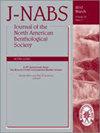Can DNA barcodes of stream macroinvertebrates improve descriptions of community structure and water quality?
引用次数: 168
Abstract
Abstract Four approaches to or levels of identifying macroinvertebrates (amateur/family, expert entomologist/genus, expert entomologist/genus–species, and DNA barcoding/species) were used to assess community structure and water quality in White Clay Creek, Pennsylvania, USA. Macroinvertebrates were collected in March 2008 from 2 riffle sites 3.9 km apart on the same stream. The downstream site was known to be degraded by land and water use. About 98% of the 1617 specimens used for analysis, including small, immature, and damaged specimens, were successfully barcoded (sequenced) for the mitochondrial cytochrome c oxidase subunit I gene. A criterion of 2 to 4% genetic divergence provided good separation of presumptive species. Barcodes increased the taxonomic inventory across the 2 sites by 475% (124 taxa) relative to the amateur level, and 125% (83 taxa) and 70% (62 taxa) relative to the expert genus and species levels, respectively. Barcoding revealed species not currently described in larval taxonomic keys, including multiple (2–11) coexisting congeneric species. That 150 species were revealed by barcoding samples collected on the same date and in the same habitat was unprecedented, as was the fact that 60 cm2 of stream bottom supported an average of 248 to 347 individuals representing 55 to 68 species. Most barcode species were rare, with 42% represented by ≤2 individuals. Across all species, 43 of 89 barcode species were unique to upstream site 11 and 60 of 107 were unique to downstream site 12. In terms of water-quality assessment, most of the 17 metrics studied changed significantly (α = 0.05) when taxonomy changed from family to genus–species (79% and 93% for sites 11 and 12, respectively), and many also changed when taxonomy changed from genus to species (59 and 65% for sites 11 and 12, respectively). The proportion of metrics able to detect a difference (α = 0.05) between sites 11 and 12 increased with improved taxonomic resolution (36, 47, 65, and 76% for family, genus, genus–species, and barcode, respectively). The results revealed a pollution-tolerance gap because barcoding pushed larval taxonomy beyond the available pollution-tolerance data. Regardless, the combined morphological and molecular approach provides a finer resolution for evaluating environmental change associated with both natural and anthropogenic processes. The ability to distinguish larvae at the species level through barcoding finally puts biodiversity assessments for aquatic communities in terms comparable to those used for terrestrial ecosystems where estimates of biodiversity for plants and animals are never quantified at the level of genus or family. We conclude that DNA barcodes of stream macroinvertebrates will improve descriptions of community structure and water quality for both ecological and bioassessment purposes.溪流大型无脊椎动物的DNA条形码能改善群落结构和水质的描述吗?
摘要采用4种鉴定方法(业余/科、昆虫专家/属、昆虫专家/属-种、DNA条形码/种)对美国宾夕法尼亚州White Clay Creek地区大型无脊椎动物的群落结构和水质进行了评价。2008年3月,在同一条河流上相距3.9公里的两个小点采集了大型无脊椎动物。已知下游地点因土地和水的使用而退化。在用于分析的1617个标本中,包括小的、未成熟的和损坏的标本,约98%成功地对线粒体细胞色素c氧化酶亚基I基因进行了条形码(测序)。2 - 4%遗传差异的标准为假定的物种提供了良好的分离。与业余水平相比,条形码技术使2个站点的分类库存量分别增加了475%(124个分类群)和125%(83个分类群),与专家水平相比增加了70%(62个分类群)。利用条形码技术发现了目前未在幼虫分类键中描述的物种,包括多个(2-11)共存的同属物种。在同一日期和同一栖息地采集的条形码样本发现了150个物种,这是前所未有的,60平方厘米的河底平均可容纳248至347个个体,代表55至68个物种。大多数条形码物种是罕见的,42%的条形码物种≤2个个体。在所有物种中,89种条形码物种中有43种是上游位点11所特有的,107种中有60种是下游位点12所特有的。在水质评价方面,当分类学由科向属-种转变时,17个指标中的大部分发生了显著变化(α = 0.05)(分别为79%和93%),当分类学由属向种转变时,许多指标也发生了显著变化(分别为59%和65%)。随着分类分辨率的提高,能够检测到位点11和位点12之间差异(α = 0.05)的指标比例增加(科、属、属-种和条形码分别为36%、47%、65%和76%)。结果显示,由于条形码将幼虫分类推到了现有的污染耐受数据之外,因此存在污染耐受差距。无论如何,结合形态学和分子方法为评估与自然和人为过程相关的环境变化提供了更好的解决方案。通过条形码在物种水平上区分幼虫的能力最终使水生群落的生物多样性评估与陆地生态系统的生物多样性评估相当,而陆地生态系统对动植物生物多样性的估计从未在属或科的水平上进行量化。我们得出结论,溪流大型无脊椎动物的DNA条形码将改善群落结构和水质的描述,用于生态和生物评价目的。
本文章由计算机程序翻译,如有差异,请以英文原文为准。
求助全文
约1分钟内获得全文
求助全文

 求助内容:
求助内容: 应助结果提醒方式:
应助结果提醒方式:


